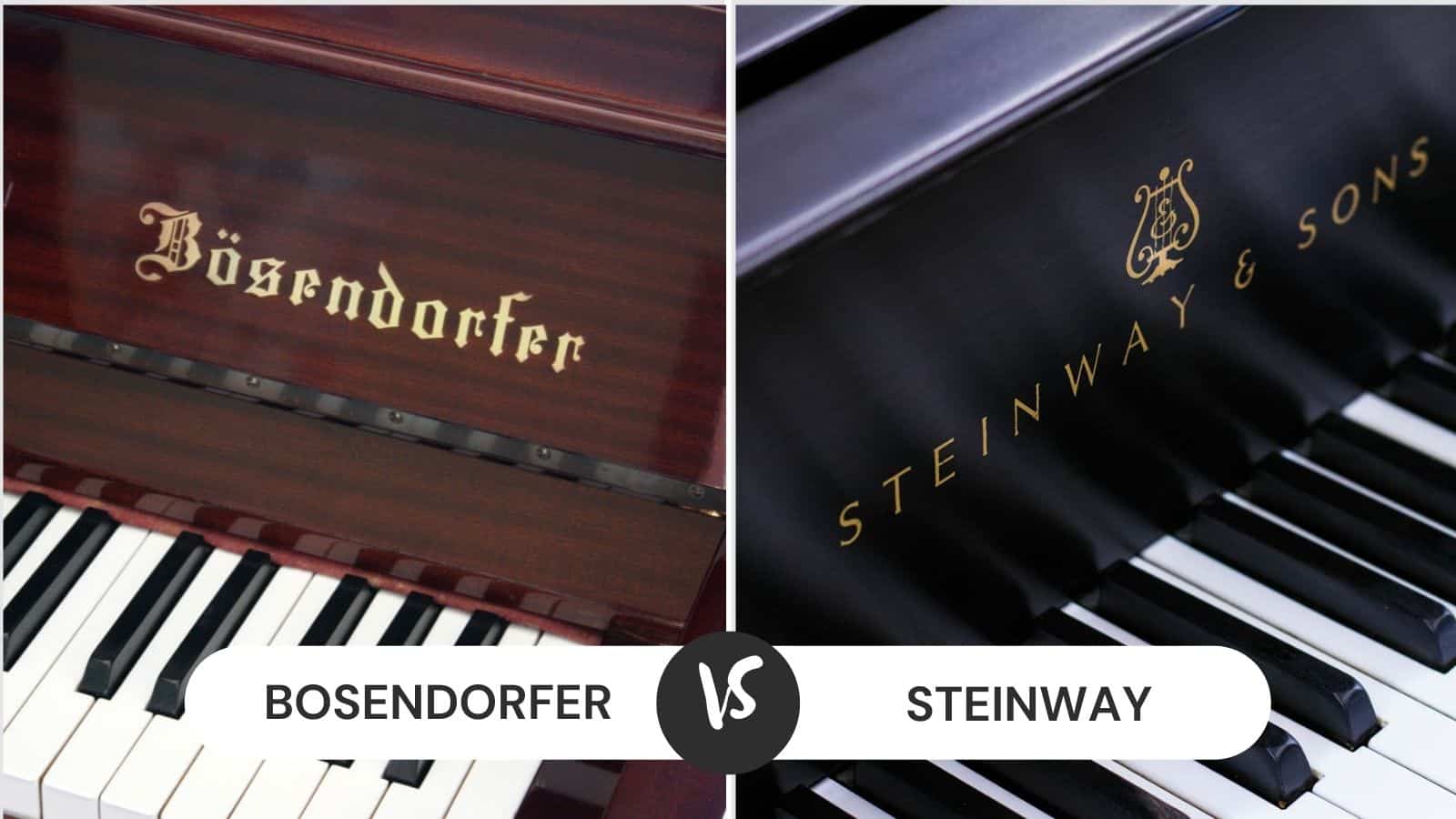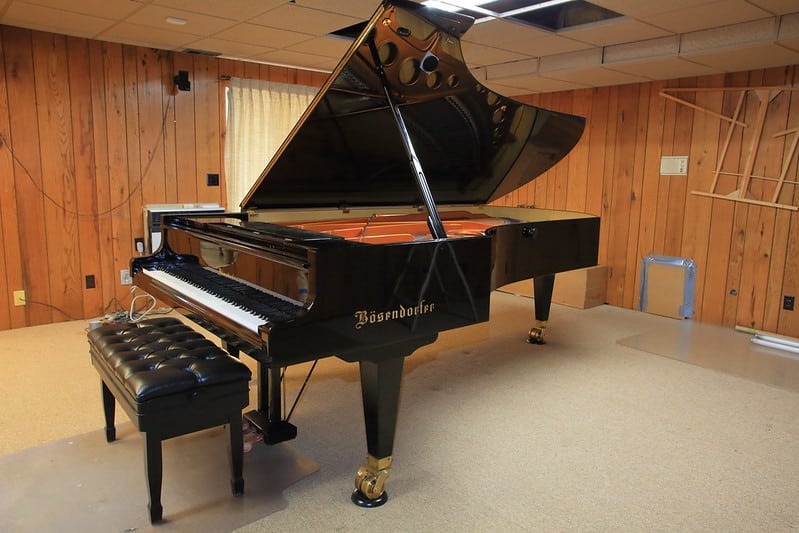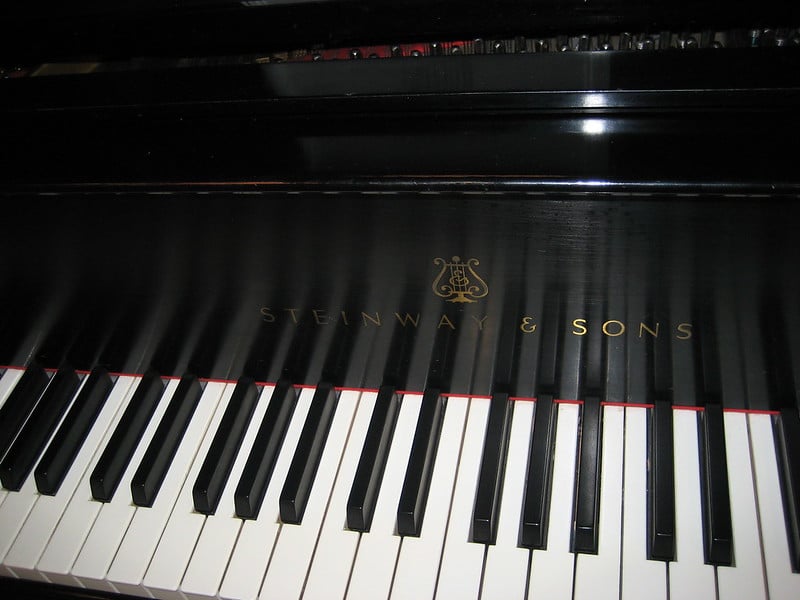
The piano is a widely used percussion musical instrument, with which you can play an array of music genres and add tunes to the music tracks.
Usually, the pianos can be used for playing the classical tones, but the quality of music and music genre depends on the piano’s brand.
Bosendorfer and Steinway are two top-notch piano brands, but it can be challenging to choose one of them. Since purchasing a new piano is a sizable investment, it’s important to make the right choice.
Comparing the Bosendorfer vs Steinway
| Features | Steinway | Bosendorfer |
|---|---|---|
| Origin | 1853 | 1828 |
| String Tension | Low | High |
| Tone | Bell-like and round tones | Pure, bright, and clear tones |
| Sustain | High | Low |
| Materials | Hardwood materials, such as maple and hard rockwood | Softwood materials, such as spruce wood |
Bosendorfer
Bosendorfer was first founded in 1828 and marked its name as the official piano maker of Austria’s emperor, but now the company is working under Yamaha as the stock was sold to Yamaha back in 2007.
The company’s headquarters are in Vienna. Bosendorfer added extra keys to the bass section of some piano models, such as the 255 model and Imperial Grand Model 290. However, the majority of them still have 88 keys.
Bosendorfer uses thick and extra strings to add resonance and the bass section creates a dark and rich sound.
These pianos have a brighter timbre and clarity as compared to the Steinway pianos as there won’t be any muddiness in the lower and mid octaves, which is why it’s preferred by classical and jazz musicians.
1. Tone
The inner rim of the pianos is made from premium Bavarian spruce wood blocks, while the outer rims are made from solid spruce wood. The outer rims are shaped by cutting out the narrow slots, which are filled with spruce shims.
For this reason, the outer rims of these pianos are thinner, while the outer and inner rims interact with the soundboard directly, making the case an extension of the soundboard. As a result, the pianos create the classical and 18th-century tones.
The upper registers of the piano have crystalline and pure sounds, but some users have said that the sound is like shattered glass or sounds tinny.
The keys designed on the lower end of Middle C are more powerful, making them suitable for fast-action pianists. The pianos have a significant Viennese tone since it has a deep bass section.
On the other hand, many pianists have complained about the uneven and treble treble section. This is why these pianos are suitable for Mozart and classical components, as the middle C section is sharp and clear but is not suitable for other genres.
2. Design
The pianos have elegant and beautiful cases with an impressive exterior and smooth finishing. In particular, the company uses jointed rims with vertical spruce wood slats.
This is the same softwood that’s used in the soundboards, resulting in softer rims. Bosendorfer has a limited number of pianos available, but they are made by the hands of highly skilled craftsmen.
This is why it can record well, but you will need custom voicing while performing at the large-scale orchestras.
Overall, the tuning and action regulation are stable, and the wood has been cured well. The company also offers customized cases.
3. Sound
The sound produced by Bosendorfer’s soundboard is absorbed by the softer spruce wood rims. This means that there will be distortions when the piano is under pressure, and there will be unpleasant and percussive sounds.
Usually, this problem occurs with the upper registers of the piano. In addition, the spruce wood rims expand and contract with the sounds, which makes it suitable for orchestral performances as long as you have custom voicing.
It helps create a bright and clean sound, given the high string tension. Below the middle C, the tones will be clear as it’s the most powerful part of the Bosendorfer pianos.
In addition to classical music, it’s also preferred by rock, blues, and jazz musicians. Some models have 91 notes, which increases the volume and power factor of the piano.
The pianos are known for their fast action and dynamic range. The top of the piano has pure and clear tones rather than warm bell tones.
However, the brand has been accused of having a brittle top end, which results in a thin tone. Keep in mind that these pianos will have a shorter sustain when playing at a higher volume.
Steinway
Steinway was founded by Henry Steinway in 1853 and was designed to achieve tonal excellence in pianos. Steinway also launched a concert venue for piano performers in New York City.
Their pianos are known for dominant keywords and bell-like music tones.
In the majority of cases, the company uses spruce wood, but the trademark soundboards are made from Sitka Spruce, which is designed with rock maple casing and leads to a rich sound.
For this reason, the Steinway pianos are preferred by professional piano performers. Currently, the company makes seven grand pianos and an upright model.
They have the most beautiful pianos, but it’s best to stay careful about the rebuilds because not all of them are approved by Steinway and don’t have genuine soundboards.
1. Tone
Steinway pianos are known to have sound and round tones in the upper keys because of the low string tension.
In addition, the tones are enhanced with the huge bent frame of hard rock maple and the soundboard made with Sitka spruce wood.
As a result, the pianists can create audible harmonics with complex and rich sound without compromising on the projection. On the other hand, the upper register has a bell-like and warm tone.
Steinway has around 135 patents for adding different features to their pianos. In particular, the pianos have evenness in the tone and complement the complex harmonics.
For this reason, it has become a versatile musical instrument as it can be used for classical, hip hop, and jazz music, along with other contemporary genres.
However, the jazz musicians don’t prefer these pianos much as they think that music isn’t precise and clear enough, but it depends on different piano models.
2. Design
Steinway pianos have a great finish and luxurious designs. The soundboards are made from spruce wood, but the back is made from hard maple wood.
In addition, the inner rim is made from bent hard rock maple wood. The pianos are designed and produced in Hamburg as well as New York, but the majority of clients have said that Hamburg-produced pianos are much better.
3. Sound
The sound produced by these pianos is bounced off the dense maple wood, which leads to powerful sound with higher sustain and clarity.
In addition, the dynamic distortion is minimal, and there are more overtones. On the other hand, the hard maple rims do not expand or contract, which can negatively impact the pitch holding capacity, so it’s not suitable for orchestral performances.
These pianos are made with English techniques, which is why there is a significant difference in the sound and build.
In particular, it has warm and signing gone because of the low string tension, which also leads to a wider dynamic range, mellow sound, and light attack. The top registers develop bell-like tones that don’t get tinny or brittle.
In addition, the sound decay is extremely even and gradual. The warmer sound of the piano also helps create audible harmonics and overtones, resulting in an appealing lush sound.
However, you must remember that if you play busy music in the lower registers, the sound will lose its clarity and definition, leading to muddled quality.
The Final Verdict
Both Bosendorfer and Steinway are known for high-end pianos, but Steinway is widely preferred by more than 90% of professional pianists.
This is because these pianos are unique on every level, leading to consistent tone, and the pianists can play multiple genres without worrying about distortion.
On the other hand, the Bosendorfer pianos are too expensive for basic features, and you’ve to pay the shipping costs as well.



I’ve played many Steinways and have a Bosendorfer. I agree in general that the higher register in Bosendorfers is brighter than Steinways. There is a TON of variation in Steinway sound – depends hugely on voicing. If you don’t like the Bosendorfer brights you can voice that down. But what you can’t do on a Steinway is bring up the bass to the Bosendorfer’s resonance.
You say the Bosendorfers aren’t suitable for concert performance unless they’re voiced – ALL pianos used in major concert halls get voiced, it’s part of basic maintenance for any serious instrument. They have to be because, due to wear, hammers can produce uneven sound.